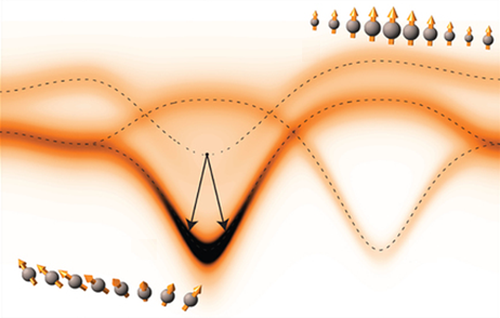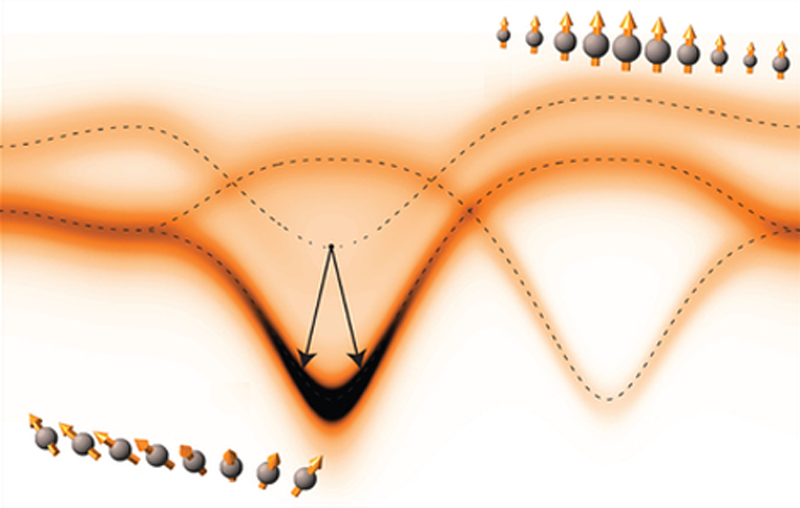Research News: Editors’ Choice
Magnetic Material Mimics Higgs Decay
A two-dimensional antiferromagnetic material could provide a condensed-matter analog for the physics of Higgs boson decay, according to a report by Jain et al. in Nature Physics. Researchers are increasingly looking into condensed-matter systems to find ways to observe otherwise inaccessible physics, from the emission of Hawking radiation to the formation of Majorana fermions. Higgs-like behavior has previously been found in materials close to the critical point of a quantum phase transition, such as superconductors and quantum magnets. Jain et al. have now found a magnetic system that could potentially simulate an important aspect of Higgs physics: the ultrafast decay of the Higgs into other particles. The researchers studied the two-dimensional antiferromagnet Ca2RuO4. By observing the material’s scattering of spin-polarized neutrons, the team provided evidence for magnetic excitations, or quasiparticles, that behave like the Higgs. They then showed that these Higgs-like quasiparticles quickly decayed into modes reminiscent of other standard-model particles called Goldstone bosons. The approach could help researchers bring the complex physics of Higgs dynamics into the range of tabletop experiments.
A New Venusian Look-Alike
A new member of the exoplanet club is sparking excitement in the astronomical community. Angelo et al. published in The Astronomical Journal their discovery of an object 219 light years from Earth—Kepler-1649b—that is strikingly similar to our bright sister planet, Venus. With help from the Kepler mission transit data and observations from the Mount Palomar Observatory in California, the team was able to analyze the flux of radiation onto the planet and the planet’s radius, concluding the size and the amount of radiation it receives from its sun is consistent with the values for Venus. This Venus doppelgänger has a few notable differences, however. Kepler-1649b takes just nine days to orbit around a sun that’s one quarter the size of our own. The group noted that by default the planet must travel much closer to its pint-sized host star to receive an amount of radiation comparable to Venus. This might subject the planet to solar flares, coronal mass ejections, and large tidal effects, which can influence seasonality and geologic activity of the star. This Venusian look-alike is now on the research docket, to understand how it differs from Earth-like planets and what conditions might lead to habitability on a planet.
Thanks for the Printed Memories
While the microcircuit industry is largely based on multibillion dollar fabrication plants, one research group has gone to the other extreme—demonstrating a production scheme that uses an off-the-shelf inkjet printer. In a paper in Applied Physics Letters, Huber et al. report a scheme that can print memory devices onto flexible substrates. The memory cells are based on the recently developed ReRAMS (resistive switching RAMs), which are based on resistance changes in a dielectric material. Each cell is made of an active layer sandwiched between two electrodes. The active region was printed with a polymer that when sintered forms a silicon oxide layer. One electrode was printed with silver nanoparticle ink and the other was a conducting polymer. When a current is sent through the oxide, a tiny metallic filament forms to create a low-resistance state (a “0”); reversing the current causes the filament to dissolve, creating a high-resistance state (a “1”). Previous attempts at printing such memory cells required costly postprinting fabrication steps, whereas Huber et al. could make the entire memory device with just a standard inkjet printer. The result may offer an inexpensive and robust way to make devices that don’t require a constant voltage supply to retain their memory.
Calorimetry “Conducts” an Atomic-Scale Experiment
A metal that can electrocute you when charged is also likely to become searing to the touch when heated. This elementary relationship between electrical and thermal conductivity is one of the basic traits of a metal and is a demonstration of physics at the macroscopic level. At the atomic scale, the way heat is transferred through single-atom junctions has been experimentally inaccessible, with no way to measure the miniscule heat currents. Chi et al. report in Science a new way to measure thermal transport through gold (Au) at the atomic scale, using a custom-built calorimetry probe. The Au-coated tip of the probe (about 50 micrometers in size) was placed over a warmer Au substrate, and the two formed an Au-Au contact when a small electrical current was run through the probe. When the probe was withdrawn from this initial position, the metal particles slowly formed single-atom junctions, and their transport properties were recorded before the contact was broken. The experiment showed that the thermal conductivity was limited to a single range of values (or quantized values), which confirmed the basic relationship between thermal and electrical currents that holds true at larger length scales. And it inspired the development of a new device to be used in future molecular-scale studies.
Kagome Magnet May Be a Gapless Spin Liquid
Antiferromagnets with a triangular structure known as the kagome lattice can be gapless spin liquids in their ground state, numerical studies now suggest. The interest in spin liquids—systems of spins that, instead of ordering ferromagnetically, remain in a disordered state—stems from the fact that they could be useful for topological quantum computers. Kagome lattices are expected to be spin liquids, but calculating their ground-state spin configurations poses a formidable theoretical challenge. Conventional methods tackle the problem by computing the largest system one can simulate on today’s computers and extrapolating the results to an infinite lattice, which best represents a real material with many electrons. But with available computing power, the lattices that can be simulated are too small to give reliable results. Now, Liao et al. have developed a new approach that finds the solution by optimizing a wave function that directly represents the infinite case. The results, reported in Physical Review Letters indicate that the ground state of the material is not only a spin liquid, but also gapless, that is, it has no energy gap between its occupied and unoccupied spin states. The tools developed through this work will help researchers describe this elusive state of matter and settle important questions about its electronic properties. (For more, see the Viewpoint in Physics, “Closing in on the Kagome Magnet” by Bryan Clark.)





